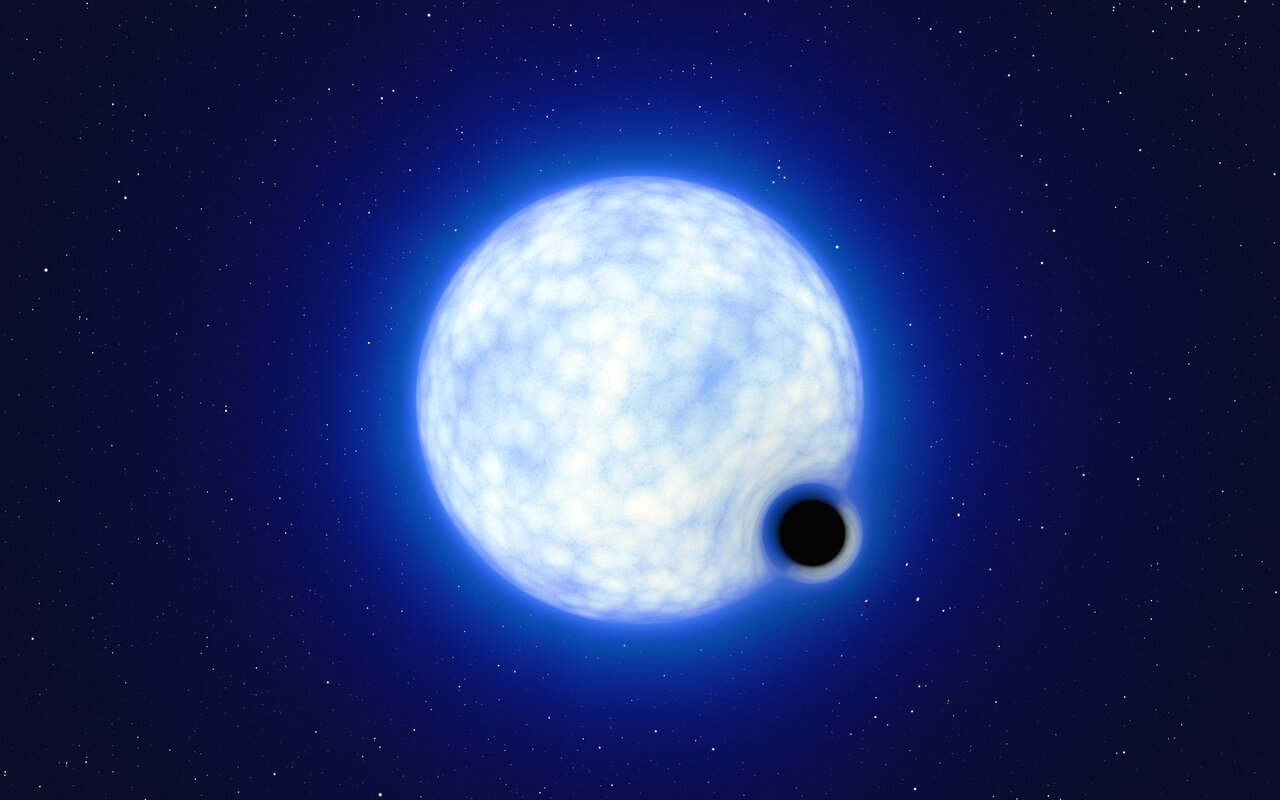Astronomers have found a dormant black hole orbiting a massive blue star in the Large Magellanic Cloud, a satellite galaxy of the Milky Way.

ESO / L. Calçada
An international team of astronomers is claiming the first unambiguous detection of a dormant black hole beyond our own galaxy. It seems to have formed without an accompanying supernova, opening the door to understanding such “direct collapse” scenarios.
Black holes are the final chapter in the lives of the most massive stars. We often find them when they are part of a binary system, locked in a gravitational dance with a massive star. The black hole reveals itself by gorging on material from its neighbour and emitting intense X-rays in the process. Occasionally, however, the black hole can be dormant or “X-ray quiet.” Until now, no X-ray quiet black hole has been observed beyond the Milky Way. “We identified a needle in a haystack,” says Tomer Shenar (KU Leuven, Belgium) who led the study that appeared in Nature Astronomy.
Shenar's team trawled through almost 1,000 stars in the Tarantula Nebula in the Large Magellanic Cloud, a satellite galaxy of our own Milky Way in the search for dormant black holes. They found exactly one, by analyzing six years of non-consecutive data from the Very Large Telescope, with some observations stretching back to 2008. In a system is known as VFTS 243, the claimed black hole orbits a massive blue star.
Showing that a binary system contains a dormant black hole is notoriously difficult, because the system could contain another dim object with the same mass. In fact, the team behind this discovery is well known for pouring cold water on the claims of other astronomers. “As a researcher who has debunked potential black holes in recent years, I was extremely skeptical regarding this discovery,” says Shenar. Backing up their claim required a little detective work.
After measuring the orbital period of the binary pair and the speed of the massive star, Shenar's team concluded that the mass of the hidden companion has the mass of between 7.2 and 10.1 Suns.
Next, they took detailed spectra of the system. The spectrum of a star is littered with absorption lines, gaps where different chemical elements within the star have swallowed that particular wavelength of light. By carefully removing the spectrum of the massive star, they were left with the spectrum of the star’s companion.
Crucially, the light from the companion contains no absorption lines or any spectral features that you would associate with an ordinary star. Coupled with the object’s high mass, that suggests that the light comes not from a star but from the material falling into a black hole.. Shenar's team also conducted modelling work to see if the observed spectrum could be explained by a dwarf star, helium star or even two stars, finding that each of those scenarios would lead to observable features in the spectrum.
ESO / Digitized Sky Survey 2 / N. Risinger / R. Gendler / ESO / M.-R. Cioni / VISTA Magellanic Cloud survey. Acknowledgment: Cambridge Astronomical Survey Unit. Music: John Dyson
Given the history of discredited dormant black hole discoveries, Shenar wanted to be absolutely sure of the result, so he asked Kareem El-Badry (Harvard & Smithsonian) to take a closer look at his work. “When [Shenar] asked me to double check his findings, I had my doubts. But I could not find a plausible explanation for the data that did not involve a black hole,” El-Badry says.
If it is indeed a black hole, there's no sign of the remains from the supernova explosion that would have accompanied its birth. "Evidence for this ‘direct-collapse’ scenario has been emerging recently, but our study arguably provides one of the most direct indications,” Shenar says. That said, most models currently suggest stars need a mass of 20 Suns or more in order to directly collapse, so it's not an open-and-shut case.
However, the direct collapse scenario is bolstered by the fact that the blue star orbits its invisible companion in a near-circular orbit. When the black hole collapsed, it must have done so in a symmetric way, without the “kick” that supernovae give collapsed cores.
“If we find more of this type of binary with circular orbits then it does suggest that direct collapse is a common way for a heavy star to end its natural life,” says Roger Blanford (Stanford University), who was not involved in the research. “This would be helpful as there are many gaps in our understanding of the mechanics of supernova explosions.”
 3
3









Comments
Peterbro3
July 24, 2022 at 2:34 pm
In the last paragraph, don't you mean black holes rather than supernova? (two places)
You must be logged in to post a comment.
Monica Young
July 27, 2022 at 3:48 pm
Thanks, Dr. Blandford has amended the quote and we've updated the article.
You must be logged in to post a comment.
Thomas Haas
August 1, 2022 at 4:39 pm
In view of the masses, should the black hole at 10 suns not be orbiting the blue star at 25 instead of the other way round ? Or is the gravity of the extremely dense black so strong ?
(Of course they would both in reality be orbiting a common barycentre)
You must be logged in to post a comment.
You must be logged in to post a comment.